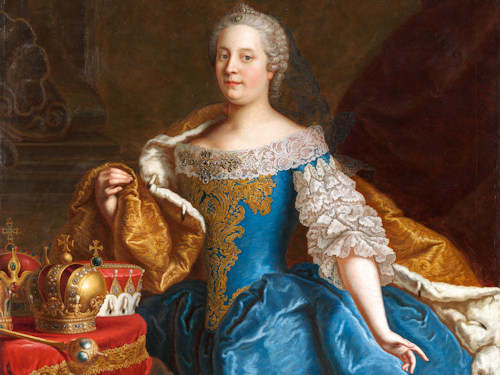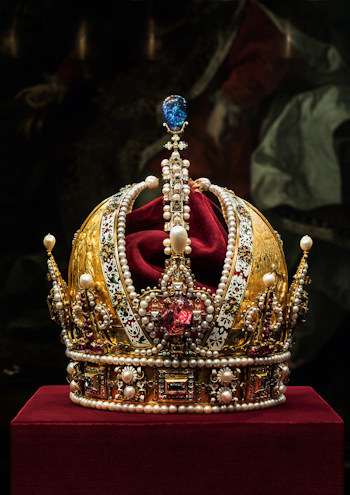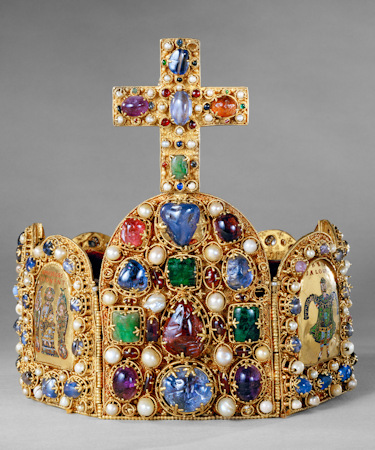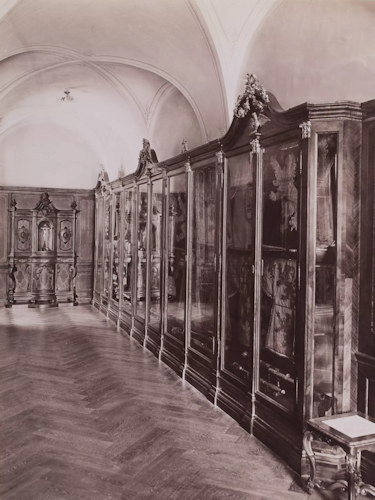The Schatzkammer (Imperial Treasury) houses the crown jewels. Literally crowns and jewels. And much more. But what are the bits to look out for?
- Both secular and ecclesiastical treasures
- Gemstones the size of goose eggs and crowns the size of Europe
- Many items of unique historical interest
- Book Imperial Treasury tickets*
- See also:
Imperial treasures

(An excerpt from the 1915 painting by Josef Pögl of Kaiserin Maria Theresia, with various Habsburg crowns. Photo by Johannes Stoll and © Belvedere, Wien. Reproduced with permission under the terms of Creative Commons License CC BY-SA 4.0.)
As my youngest son once put it…if you’re a royal with money, you want what the other royals have but bigger and more expensive.
My wife claims they needed all that grandeur for representational and propaganda purposes. Something to impress monarchs and peasants alike.
And I wonder if one or two emperors weren’t, um…compensating.
Anyway, prepare for a feast of Imperial treasure marking hundreds of years of European history: priceless items worn or owned by those who often bent that history to their will.
Here some of my favourites from my last visit to the Schatzkammer collection…
Habsburg crown jewels
The Habsburg dynasty ruled over much of central and eastern Europe for centuries. So they accumulated a fair few items of Imperial and royal paraphernalia.
For example, a crown should be all gold, diamonds, rubies and sapphires, with delicate enamel designs and Imperial scenes in relief.
Step forward the magnificent 1602 crown of Rudolf II that became the Habsburg Imperial crown. This forms, perhaps, the centrepiece of the Imperial Treasury:

(Photo of the Crown of Rudolf II, later Crown of the Austrian Empire, Jan Vermeyen, Prague, 1602 ©KHM-Museumsverband. You see a funereal copy of the crown on a tour of the Michaelerkirche crypts)
Exhibits like this rather-impressive headwear provide a direct link to the past. A link made even more tangible when the items on display also appear in old paintings hanging nearby.
For example, Rudolf’s crown, orb, and scepter feature in the 1832 van Amerling portrait of Emperor Franz II/I that adorns the wall in the same gallery.
Franz looks tired, as if he knows the dynasty is on borrowed time (less than 90 years until its end, actually). Oh, and the mantle around his shoulders lies in the neighbouring room.
Other Habsburg highlights:
- The 1496 ceremonial sword of Emperor Maximilian I, with its remarkable designs along the blade
- The Ainkhüm sword from the early 15th century with a scabbard made out of a narwhal tusk (believed back then to be the actual horn of a unicorn)
- The garments associated with the chivalric Order of the Golden Fleece, including an original chain of the order from the mid-15th century
(The garments are but one of many treasures from the rich Burgundian part of the early Habsburg dominions.)
Ah, but what about the jewels part of the idea of crown jewels? Well, how about…
- A 1641 vessel made from a 2,680 carat emerald
- The 1687 Hyacinth “la Bella”, a huge garnet the size of a goose egg
- An 1818/19 rose bush made of gold
- A silver and gold egg cup that once belonged to King Louis XVI of France
A particular treasure from later Habsburg times is the throne cot presented to the second wife of Napoleon (Marie Louise, the daughter of the first Emperor of Austria, the aforementioned Franz) for her son.
The “Cradle of the King of Rome” holds over a quarter of a ton of precious metals in it. Can’t help but feel that a kid sleeping in that is going to feel a certain amount of pressure in terms of expectations.
The Holy Roman Empire

(The Reichskrone crown of the Holy Roman Empire. Made of gold, enamel, gemstones, glass stones, pearls, and iron. Press photo © KHM-Museumsverband)
The Holy Roman Emperor was also a Habsburg for almost the entire period from 1452 to its 1806 dissolution.
Among the treasures from that particular European institution:
- The silk coronation mantle from 1133/34, which enveloped the shoulders of many iconic rulers
- The robes worn by the King of Bohemia when electing the Holy Roman Emperor, made around 1625-1650
- The Imperial crown of the Holy Roman Emperor, dating back to 960-980 (or possibly later)
Albrecht Dürer’s famous 1512(?) painting of Charlemagne wearing that crown hangs nearby. Dürer’s portrayal plays fast and loose with historical accuracy, though; Charlemagne died in 814, so never wore this particular headpiece.
We should soon know more about the Imperial crown’s true age, manufacture, history and material composition thanks to an ongoing interdisciplinary and international research project at the Kunsthistorisches Museum.
The displays include other items from closer to Charlemagne’s time, allegedly removed from his tomb…
- The Imperial gospels from ca. 800
- Charlemagne’s sabre from the early 10th century
- St. Stephen’s Burse reliquary from the early 9th century
The list of items gives me goosebumps: a confluence of history, priceless materials, and exquisite workmanship.
And, at the same time, all a reminder that one day the crown is on your head, the next it’s being gawped at by an Englishman whose primary concern is whether he can justify eating a second mint chocolate ice cream later.
Want more?
If your lust for Imperial treasures remains unsatisfied, can I recommend the nearby Kunstkammer and Silberkammer collections. The Habsburgs were not short of a penny or two (though still managed to run up debts).
Or make the short trip to Klosterneuburg at the edge of Vienna and visit the abbey treasury, which has, for example, the Austrian Archducal coronet from the early 1600s.
Religious treasures

(View of the relic cabinets in the Schatzkammer, photographed by August Stauda around 1900; Wien Museum Inv.-Nr. 106081/13; excerpt reproduced with permission under the terms of the CC0 licence)
The Imperial Treasury also houses an ecclesiastical collection, which begins with two unique items from the “do-not-ever-sell” category of the Habsburg treasures:
- The largest carved agate bowl in the world, produced in the 4th century. Apparently the word “Christ” is inscribed in Greek letters in the actual (natural) substance of the stone, though it takes more imagination than I’ve got to see it
- A narwhal tusk from the early-16th century, believed to be (as with the Ainkhüm sword scabbard) from a unicorn
The remaining ecclesiastical exhibits consist mainly of reliquaries presented in beautiful wooden cabinets topped with golden decoration. I believe these may be the original display cabinets from the time of Emperor Franz Joseph. They include various alleged Christian relics:
- A piece of wood from the manger
- A tooth from John the Baptist
- A piece of the Last Supper tablecloth
- A nail used to pin Jesus’s hand to the cross
- …and thorns from the crown he wore
- A snippet of Jesus’s loincloth
- ..and many more of this nature
One can argue about authenticity, but I leave that debate to those with more expertise.
For more ecclesiastical relics and treasures, pop over to the Dom Museum next to Stephansdom cathedral or the Klosterneuburg treasury mentioned above.
Tickets & visitor tips
For ticket info, general impressions, visitor tips, directions etc. for the Imperial treasury, check the main Schatzkammer page.
